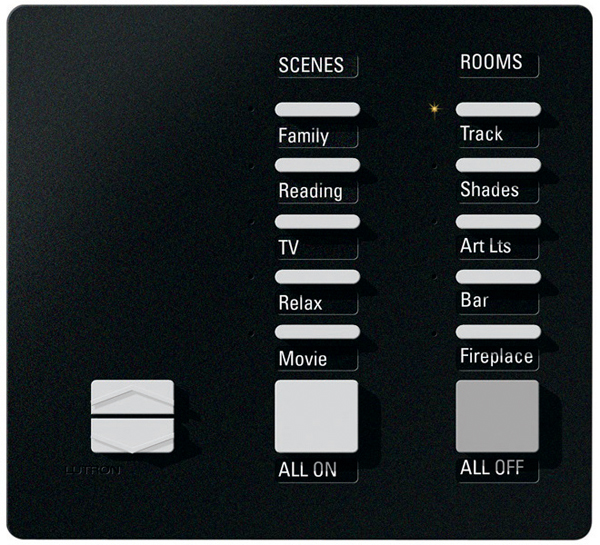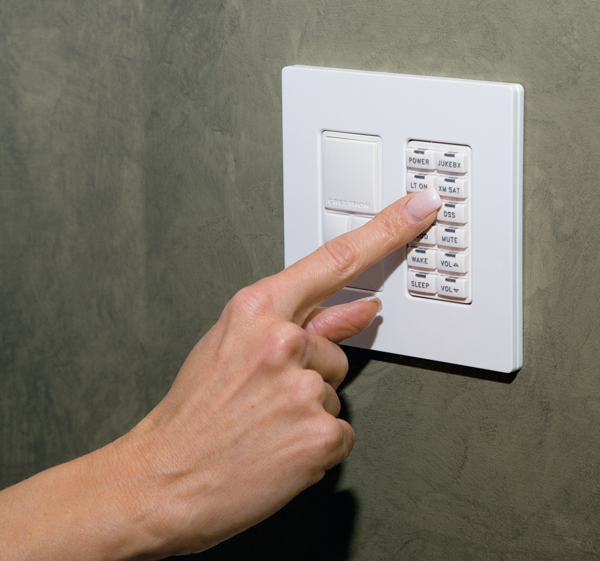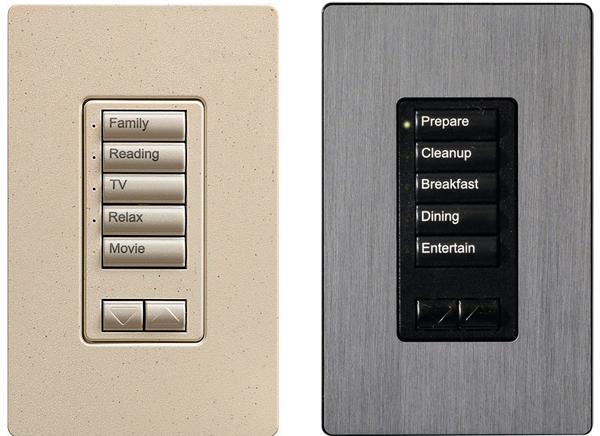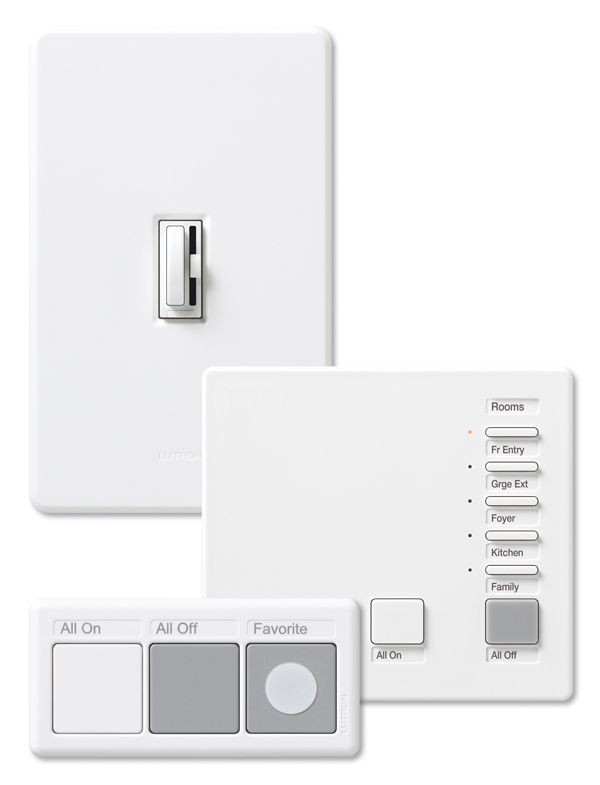Lighten Up
 One of the myths about lighting control systems is that you can only install them if you’re building a new house, where the walls aren’t built yet, or if you’re performing a major remodel, where all of the walls are torn down. This myth perpetuates on the assumption that you need to run lots of wire while the framing is exposed. It’s true that once the drywall is up, pulling wire becomes prohibitively expensive because of the labor required. But I’m here to bust the myth that you can’t have fun with your lighting in a finished home. In the case of lighting dimming control, you can enjoy many of the features you’d find in a whole-house wired system, without the wire and the accompanying labor expense.
One of the myths about lighting control systems is that you can only install them if you’re building a new house, where the walls aren’t built yet, or if you’re performing a major remodel, where all of the walls are torn down. This myth perpetuates on the assumption that you need to run lots of wire while the framing is exposed. It’s true that once the drywall is up, pulling wire becomes prohibitively expensive because of the labor required. But I’m here to bust the myth that you can’t have fun with your lighting in a finished home. In the case of lighting dimming control, you can enjoy many of the features you’d find in a whole-house wired system, without the wire and the accompanying labor expense.
I’ll show you what’s possible in lighting for existing homes and offer an overview of products from several key wireless lighting brands. You can accomplish the miracle of wireless lighting control via radio frequency (RF), a technology that uses specific, dedicated frequencies upon which the command signals travel. Unlike infrared (IR) signals, which your garden-variety handheld TV remote control uses, RF signals don’t have to be pointed; they can travel through walls and are generally stable. All of the wireless lighting systems I’ll discuss here are RF, and there are some new platforms within this technology.
Go Wireless
Wireless lighting systems can provide most of the important features that wired systems offer. Let’s start with safety and security. Many wireless brands let you control your lighting, gates, and garage doors from a car visor control. When you’re inside your home, you can program the wireless lighting system to flash all lights that are connected to the system in the event of a security breach. And to keep you from stumbling around in the dark to get a drink of water, lighted interior pathways keep you on the right trackŃjust like an expensive wholehouse wired system.
Before we go further, let’s define some terms. When we discuss lighting control in a particular room, that includes all of the room’s various circuits. You can set the intensity of each circuit individually, but they all combine into one scene. An example might be a living room that features a bank of in-ceiling light cans close to one long wall, several floor or tabletop lamps around a sofa, and one or two spotlights to accent art, like a special litho or a meaningful collectible.
A lighting control system lets you preset several scenes. You might set the levels for Party mode, where all of the lights are darn near full on. For a more relaxing environment, you might set levels for Read mode, where the lamps are high but the ceiling cans and art spots are dimmed down for tasteful accents. If your A/V system is located in a multipurpose room, another scene might be Movie, where a few lights are barely on, or perhaps only one light is on for safety. Some systems let you set global levelsŃpreset scenes within each room for the entire house. With presets, you don’t need to manually adjust the settings of the individual circuits in every room.
Home Advantage Mood and scene lighting are fundamental to the interior design and arch- itecture of luxury homes. Once you sculpt your own living environment with lighting control, you’ll see that it can make a profound difference in lifestyle and mood. Rooms that have overwhelming surgical overhead lamps can make you feel like you’re being interrogated. A well-lit room can completely change your outlook on life, like being in a spa at the perfect temperature. I’m on my best behavior in a well-lit environment, and you will be too.
This isn’t to say that people who live in luxury homes are better behaved, but even a modest wireless lighting control system will pay off for many years. As for the home’s exterior, nighttime lighting accents can bring an air of magic to any landscaping.
Saving energy is important to many people these days, and there are several ways to accomplish this with lighting. Lighting and dimming controls help keep lights from running unattended for extended periods, which saves energy and dollars. When in use, these controls dim the lights to the required level. Occupancy sensors provide light when you need it and save energy by shutting off the lights when the room is unoccupied. This is especially important for those easy-to-forget areas where lights are often left to blaze.
A plethora of other features are available in more advanced wireless lighting dimming systems. You can spotlight kitchen work surfaces, your dining room table, or pieces of art. You can also create cozy reading nooks, family room movie macros, or master bath functions. You can set up high-level Makeup, Shaving, or Toenail controls or even create a setting for a quiet, relaxing bath. Your master bedroom settings might include Soothing Nightlights and well. You can even incorporate global house settings, like Entertain and Nighty Night, and control them via Web-based interfaces.
Of course, the fun (and the work) is setting the various levels to get just the right look for each preset or scene. In the luxury market, a lighting designer creates the scenes and selects the fixtures. More advanced systems let you make changes on the fly and store them without the need for a house call by a laptop-wielding programmer. You don’t have to get it right the first time, and changes are easy if you change your mind.

The Major Players
The major lighting control manufacturers have complete lines of productsŃmulti-button wall-mount and tabletop keypads, dimmers and master controls that all communicate via wireless RF. Before I discuss several brands of wireless products, I want to mention that there are a number of manufacturers in this market, and the purpose of this article is not to present a complete summary of every manufacturer’s offerings. Let me apologize in advance to those brands I didn’t mention. The main purpose is to enlighten the readers (forgive the pun) about enjoying lighting control via wireless RF in a completed home. I chose the following brands simply because they offer great examples of representative features. You can also find many of these features in other manufacturers’ lines.

Lutron HomeWorks and RadioRA
Perhaps the best-known brand of wireless RF lighting is Lutron, which has two main systems, the HomeWorks Wireless and the RadioRA. Ra is the ancient Egyptian sun god. One of the real pleasures of a lighting dimming system is its ability to control the entire home from a central location, via tabletop or wall-mounted keypads, thus avoiding the need to go on house patrol. One touch sets your Welcome Home scenes. Another triggers your Entertain presets. Still another, the Away mode, programs the house to appear as if someone is home. You can expand Lutron wireless RF systems to include more areas by placing RF signal repeaters strategically throughout the home.
Lutron RadioRA is a two-way system. In this kind of system, a device, say a wall plate, generates a command and receives a status feedback signal in return to confirm that the signal was received. This is an example of a fixed network, which includes dedicated sending, receiving, and computing stations in predetermined locations. The advantage to a fixed system is the predetermined signal route, which provides fast, predictable reaction time, regardless of the originating keypad’s location.
Lutron has developed a big following among several trades, not the least of which is interior design. This is partly due to its vast collection of keypad colors and finishes. Its line includes virtually every finish, and if the finish you want doesn’t exist, you can custom paint or finish Lutron keypads to match your room’s dŽcor. RadioRA includes sophisticated features that typically belong to the world of wired systems. An example is the Chronos system bridge. This interface includes an astronomical time clock to schedule lighting and window treatment control relative to sunrise and sunset. A great application is the control of motorized window shades. You can automatically set shades on east- or west-facing windows to protect the interior (including valuable antiques and rugs) from intense morning or late-afternoon sun. Chronos can also simulate your daily routines, which gives the appearance that someone is home when you’re away.

Crestron infiNET Crestron is a well-respected brand in residential control. Its infiNET wireless products have an engineering-driven perspective. For example, since every keypad is a receiver as well as a repeater, the system can expand with greater range among the devices and strengthen as it grows. Crestron infiNET features a built-in spectrum analyzer that should make installation quick, easy, and reliable. Installers can monitor the RF activity throughout a space during system setup and select the best locations for gateways and devices. Since the infiNET wireless system requires a main processor, it’s also expandable to interface with additional Crestron wholehouse control systems and other controllable subsystems, such as motorized skylights, windows, shades, drapes, and climate control (HVAC thermostats).
If you live in a smaller space, you’ll be happy to know that there are expandable lighting control packages that address a more modest scope.
GE Z-Wave
General Electric Z-Wave Wireless Lighting Control is an easy-to-install, affordable system that controls small appliances and thermostats via a handheld remote control. Several manufacturers share Z-Wave technology, so their lighting control products are compatible. Z-Wave doesn’t require a central processor, and it uses an isolated radio frequency. The manufacturer says that this allows the system to work with less opportunity for dropped signals. The advantage is non-interference with Wi-Fi, Bluetooth, 2.4-gigahertz, and 5.8-GHz products within the same environment. This is an example of a mesh system. Let’s say you want to give the command “Turn on Kitchen Lights” when you are at a distance from the kitchen. Since all modules communicate with each other, the command can relay through several devices and finally to the kitchen module.
The GE system is modular, and you can start with a simple two-piece scheme, like a GE Z-Wave Remote and Lamp Module. The one-gang wall-power dual receptacles and wall-plate dimmers appear remarkably normal. The petite modules that control fluorescents, floor lamps, and appliances are innocuous looking. GE handheld remotes provide two-way visual feedback to let you know if the system is set up properly and if the signal is received.
Control4
Control4 manufactures affordable wholehouse control systems. Its wireless products, such as its wireless lighting system, use ZigBee technology. This is an example of a mesh network, where messages relay from a source device through any other devices to reach their destination. The devices in the network form a matrix of possible message delivery routes. If a preferred route isn’t available, a mesh network can easily identify another route. The technology is known for its rapid response to executed commands (low latency), low cost, and very low energy consumption. The ZigBee Alliance is a group of companies that have adopted the ZigBee open platform for wireless connectivity and functionality throughout the home. A mesh network can use any participating manufacturer’s device for message relay, but you should exercise some caution in using components from multiple manufacturers. If you need service, it might be easier to deal with a single manufacturer.
Control4 wireless lighting systems include dimmers, wall plate switches, attractive touchscreens, keypads, and handheld remote controls. One of its very effective marketing visualizations shows a very slow ramp-up from no light (pre-dawn) to full (morning) light, which provides a dawn-like wake-up experience. You can also program the system for a lived-in simulation while you’re away from your home. The wireless dimmer is certified for wireless control of up to 1,000 watts. Remember our little exercise with various circuits per room? Those 1,000 watts can accommodate a whole bunch of lights.

Lutron AuroRa
Lutron’s AuroRa system provides remote control of five lights in your home that you can operate from a bedside Master Control or a Wireless Controller on your car visor. The AuroRa system is preconfigured and ready to operate right out of the box. It’s as simple as replacing five wall switches with AuroRa dimmers and plugging the Master Control and Central Antenna into a standard household outlet. You set the light levels locally using the slider on each dimmer. Each dimmer can control up to 600 watts of incandescent or halogen lighting. Remember, this system is limited. It can only control lights that were connected to the original wall switch. You can also expand it by adding a second complete system. The Central Antenna has a range of about 30 feet in every direction. AuroRa uses discrete wireless RF, so it avoids the false signals and interference generated by other appliances on power line carrier control systems, which is typically found at this price point.
To Wrap Up I hope you’ve learned that you can enjoy RF lighting control without knocking down your walls and rebuilding. I want to thank Erik Vidrio, operations manager at Sound Solutions for his technical and product expertise, which helped make writing this article an enlightening experience. We know you will be delighted with the results in your home.





























































